人教版七年级英语全英说课稿Unit 5 What were you doing when the rainstorm came
- 格式:doc
- 大小:25.00 KB
- 文档页数:2
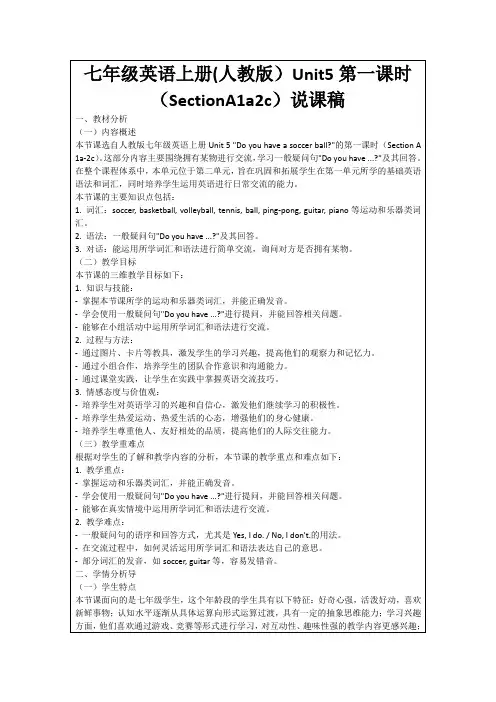
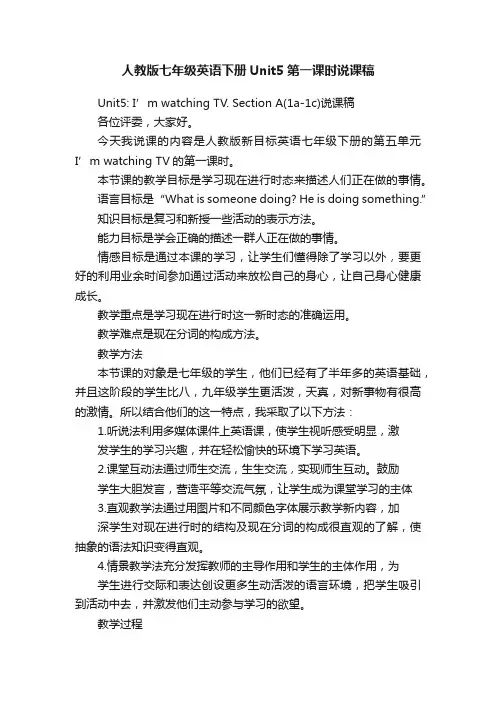
人教版七年级英语下册Unit5第一课时说课稿Unit5: I’m watching TV. Section A(1a-1c)说课稿各位评委,大家好。
今天我说课的内容是人教版新目标英语七年级下册的第五单元I’m watching TV的第一课时。
本节课的教学目标是学习现在进行时态来描述人们正在做的事情。
语言目标是“What is someone doing? He is doing something.”知识目标是复习和新授一些活动的表示方法。
能力目标是学会正确的描述一群人正在做的事情。
情感目标是通过本课的学习,让学生们懂得除了学习以外,要更好的利用业余时间参加通过活动来放松自己的身心,让自己身心健康成长。
教学重点是学习现在进行时这一新时态的准确运用。
教学难点是现在分词的构成方法。
教学方法本节课的对象是七年级的学生,他们已经有了半年多的英语基础,并且这阶段的学生比八,九年级学生更活泼,天真,对新事物有很高的激情。
所以结合他们的这一特点,我采取了以下方法:1.听说法利用多媒体课件上英语课,使学生视听感受明显,激发学生的学习兴趣,并在轻松愉快的环境下学习英语。
2.课堂互动法通过师生交流,生生交流,实现师生互动。
鼓励学生大胆发言,营造平等交流气氛,让学生成为课堂学习的主体3.直观教学法通过用图片和不同颜色字体展示教学新内容,加深学生对现在进行时的结构及现在分词的构成很直观的了解,使抽象的语法知识变得直观。
4.情景教学法充分发挥教师的主导作用和学生的主体作用,为学生进行交际和表达创设更多生动活泼的语言环境,把学生吸引到活动中去,并激发他们主动参与学习的欲望。
教学过程一复习热身,引导激情。
简单复习第4单元学习的职业和未来的愿望,使学生能用学过的知识与陌生的老师培养些默契,同时也激发他们的回答欲望。
二呈现新课,总结规律。
以现在教室里的授课教师,学生,听课教师为例,老师表述此时的这些人正在做事情,先帮学生对现在进行时有个初步印象,然后通过多张图片表示的动作来操练现在进行时的结构。
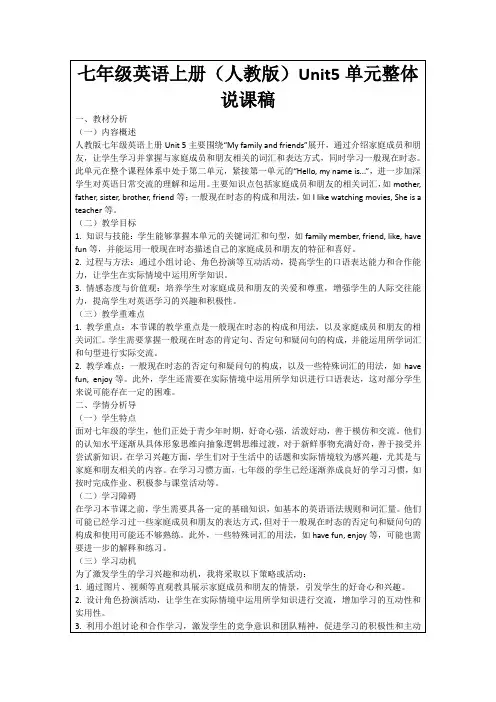

七年级英语下册第五单元说课稿
教材的地位及作用
本课以描述人物正在进行的活动为主题,谈论日常生活中经常发生的动作和存在的状况,达到增进学生和师生之间相互了解的目的。
教学目标
知识目标
whatareyoudoing?I'mwatching.
whatishedoing?heisdoinghomework.
isshereading?no,sheisdoingherhomework.
能力目标
能在同学之间进行模拟的动作表演,描述或让对方猜测自己,朋友或家庭成员正在进行的动作,或存在的状况。
情感目标
通过对人物活动个性化的描述,培养学生尊重和理解别人学会交换不同的看法,了解他人的爱好,增进情谊。
教学重点及难点
掌握并运用描述人物活动和地点的词汇:
掌握并运用简单的英语交际句型:
教法设计
本课我主要采用了如下几种教学方法:
采用多媒体进行直观教学,在不同图片的展示中说出本单元要求学习的主要句子结构。
听录音
听音是学生学习英语的重要方法,也是课堂教学的重要步骤,在听中可以感知,可以模仿。
一些学生难以理解的词句型,短语句子或某一语法现象进行解释,反复练习,达到可灵活运用的程度。
采用各种方法让学生进行多种形式的情景对话,从而达到对教材内容的全部操练。
两人一组,在看系列图片的同时进行对话,一问一答,并完成书上的表格,猜测这些人都在做什么。

人教版七年级下册英语unit5说课稿英文IntroductionHello everyone, today I will talk about Unit 5 of the 7th grade English textbook published by People's Education Press. The title of this unit is "Do you want to watch a game show?" This unit mainly focuses on expressing preferences and making choices through various activities.Part 1: VocabularyIn this unit, students will learn a variety of new vocabulary related to game shows, such as "game show," "contestant," "host," "prize," and so on. Through learning these new words, students will be able to better understand and communicate about game shows and related topics.Part 2: GrammarIn terms of grammar, this unit focuses on the use of modal verbs to express degrees of possibility and certainty, such as "might," "may," and "must." Through practice exercises, students will be able to use these modal verbs to express their own preferences and make choices in various situations.Part 3: Listening and SpeakingThis unit includes a number of listening and speaking activities, which provide students with opportunities to practice their listening and speakingskills. For example, students will listen to a game show and answer questions about it, and engage in discussions about their own preferences and choices.Part 4: Reading and WritingIn terms of reading and writing, this unit includes a short article about a popular game show, as well as writing exercises that help students practice expressing their own preferences and opinions. Through these activities, students will be able to develop their reading and writing skills within the context of game shows and related topics.ConclusionOverall, Unit 5 of the 7th grade English textbook published by People's Education Press is an engaging and interactive unit that provides students with a variety of opportunities to practice their language skills. Through learning new vocabulary, grammar, and practicing listening, speaking, reading, and writing, students will be able to communicate effectively about game shows and related topics.。
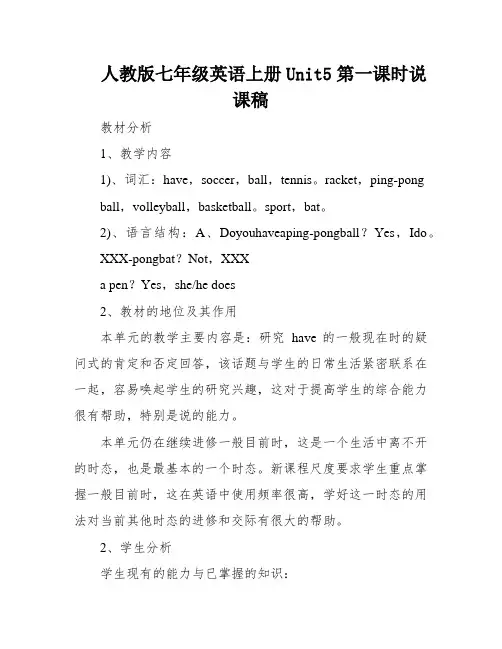
人教版七年级英语上册Unit5第一课时说课稿教材分析1、教学内容1)、词汇:have,soccer,ball,tennis。
racket,ping-pongball,volleyball,basketball。
sport,bat。
2)、语言结构:A、Doyouhaveaping-pongball?Yes,Ido。
XXX-pongbat?Not,XXXa pen?Yes,she/he does2、教材的地位及其作用本单元的教学主要内容是:研究have的一般现在时的疑问式的肯定和否定回答,该话题与学生的日常生活紧密联系在一起,容易唤起学生的研究兴趣,这对于提高学生的综合能力很有帮助,特别是说的能力。
本单元仍在继续进修一般目前时,这是一个生活中离不开的时态,也是最基本的一个时态。
新课程尺度要求学生重点掌握一般目前时,这在英语中使用频率很高,学好这一时态的用法对当前其他时态的进修和交际有很大的帮助。
2、学生分析学生现有的能力与已掌握的知识:学生在已经学过词汇:What is this?What is that?句型:XXX…经过前面的研究学生已经积累了一定的词汇,掌握了一定的目标语,已经具备了一定的听说读写能力。
三、教学目标1、语言知识词汇:A、重点掌握表示有关各种运动球类的名词,如basketball。
soccerball,so on重点句型。
Do you/they have a TV?Yes,I/theydo./No,I/they don’t.XXX?Yes,he/she does./No,he/she doesn’t.2、语言技能1)、能看着图片说;Do you/they have a TV?Yes,I/theydo./No,I/they don’t.XXX?Yes,he/she does./No,he/she doesn’t.3、进修战略11)、利用教师所提供的图片卡片做出简单的判断。
2)、通过与同学交流,学会使用一般现在时的疑问形式及肯定和否定回答。
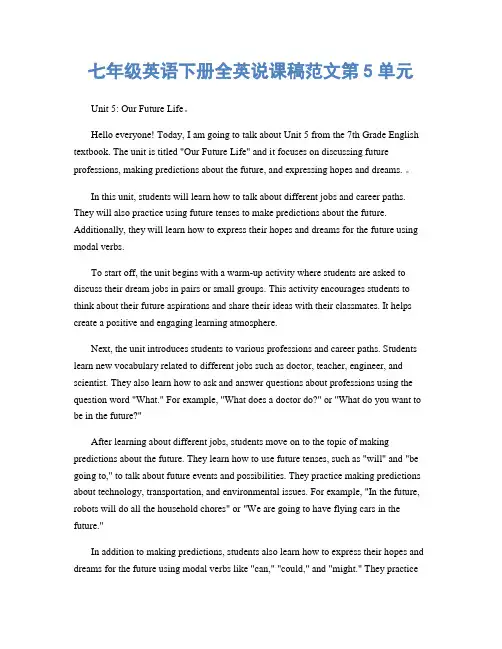
七年级英语下册全英说课稿范文第5单元Unit 5: Our Future Life。
Hello everyone! Today, I am going to talk about Unit 5 from the 7th Grade English textbook. The unit is titled "Our Future Life" and it focuses on discussing future professions, making predictions about the future, and expressing hopes and dreams. 。
In this unit, students will learn how to talk about different jobs and career paths. They will also practice using future tenses to make predictions about the future. Additionally, they will learn how to express their hopes and dreams for the future using modal verbs.To start off, the unit begins with a warm-up activity where students are asked to discuss their dream jobs in pairs or small groups. This activity encourages students to think about their future aspirations and share their ideas with their classmates. It helps create a positive and engaging learning atmosphere.Next, the unit introduces students to various professions and career paths. Students learn new vocabulary related to different jobs such as doctor, teacher, engineer, and scientist. They also learn how to ask and answer questions about professions using the question word "What." For example, "What does a doctor do?" or "What do you want to be in the future?"After learning about different jobs, students move on to the topic of making predictions about the future. They learn how to use future tenses, such as "will" and "be going to," to talk about future events and possibilities. They practice making predictions about technology, transportation, and environmental issues. For example, "In the future, robots will do all the household chores" or "We are going to have flying cars in the future."In addition to making predictions, students also learn how to express their hopes and dreams for the future using modal verbs like "can," "could," and "might." They practicediscussing what they would like to do or achieve in the future. For example, "I can become a successful musician" or "I could travel around the world."To reinforce the new vocabulary and language structures, the unit provides various activities and exercises. Students engage in role-plays, group discussions, and pair work to practice using the target language in meaningful contexts. They also have the opportunity to listen to audio recordings and watch videos related to the topic, which helps improve their listening skills.Furthermore, the unit includes a reading passage about a girl named Emma who dreams of becoming an astronaut. The passage not only provides reading practice but also serves as a source of inspiration for students to pursue their own dreams. It encourages them to believe in themselves and work hard to achieve their goals.To assess students' understanding of the unit, there are both formative and summative assessments provided. These include quizzes, writing assignments, and oral presentations. These assessments allow teachers to gauge students' progress and provide feedback to help them improve.In conclusion, Unit 5 "Our Future Life" is an engaging and informative unit that focuses on discussing future professions, making predictions, and expressing hopes and dreams. It provides students with the necessary vocabulary and language structures to talk about their future aspirations. Through a variety of activities and assessments, students have the opportunity to develop their language skills and gain confidence in expressing their ideas about the future.。
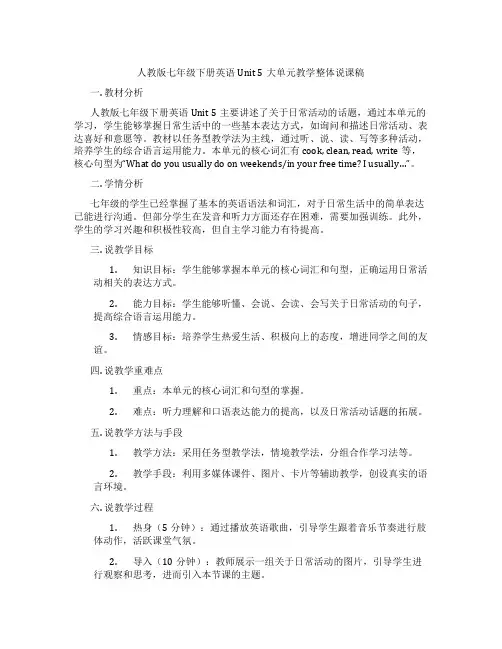
人教版七年级下册英语Unit 5大单元教学整体说课稿一. 教材分析人教版七年级下册英语Unit 5主要讲述了关于日常活动的话题,通过本单元的学习,学生能够掌握日常生活中的一些基本表达方式,如询问和描述日常活动、表达喜好和意愿等。
教材以任务型教学法为主线,通过听、说、读、写等多种活动,培养学生的综合语言运用能力。
本单元的核心词汇有cook, clean, read, write等,核心句型为“What do you usually do on weekends/in your free time? I usually…”。
二. 学情分析七年级的学生已经掌握了基本的英语语法和词汇,对于日常生活中的简单表达已能进行沟通。
但部分学生在发音和听力方面还存在困难,需要加强训练。
此外,学生的学习兴趣和积极性较高,但自主学习能力有待提高。
三. 说教学目标1.知识目标:学生能够掌握本单元的核心词汇和句型,正确运用日常活动相关的表达方式。
2.能力目标:学生能够听懂、会说、会读、会写关于日常活动的句子,提高综合语言运用能力。
3.情感目标:培养学生热爱生活、积极向上的态度,增进同学之间的友谊。
四. 说教学重难点1.重点:本单元的核心词汇和句型的掌握。
2.难点:听力理解和口语表达能力的提高,以及日常活动话题的拓展。
五. 说教学方法与手段1.教学方法:采用任务型教学法,情境教学法,分组合作学习法等。
2.教学手段:利用多媒体课件、图片、卡片等辅助教学,创设真实的语言环境。
六. 说教学过程1.热身(5分钟):通过播放英语歌曲,引导学生跟着音乐节奏进行肢体动作,活跃课堂气氛。
2.导入(10分钟):教师展示一组关于日常活动的图片,引导学生进行观察和思考,进而引入本节课的主题。
3.呈现(10分钟):教师通过课件展示本节课的核心词汇和句型,并进行讲解和示范。
4.练习(15分钟):学生分组进行角色扮演,模拟日常活动的场景,运用所学词汇和句型进行交流。
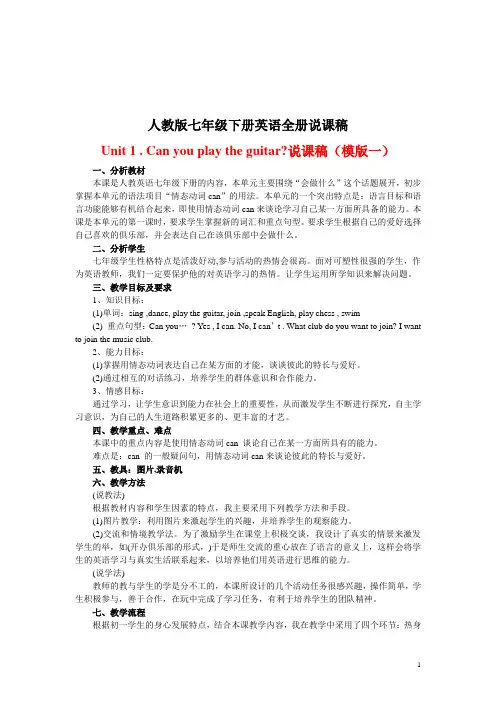
人教版七年级下册英语全册说课稿Unit 1 . Can you play the guitar?说课稿(模版一)一、分析教材本课是人教英语七年级下册的内容,本单元主要围绕“会做什么”这个话题展开,初步掌握本单元的语法项目“情态动词can”的用法。
本单元的一个突出特点是:语言目标和语言功能能够有机结合起来,即使用情态动词can来谈论学习自己某一方面所具备的能力。
本课是本单元的第一课时,要求学生掌握新的词汇和重点句型。
要求学生根据自己的爱好选择自己喜欢的俱乐部,并会表达自己在该俱乐部中会做什么。
二、分析学生七年级学生性格特点是活泼好动,参与活动的热情会很高。
面对可塑性很强的学生,作为英语教师,我们一定要保护他的对英语学习的热情。
让学生运用所学知识来解决问题。
三、教学目标及要求1、知识目标:(1)单词:sing ,dance, play the guitar, join ,speak English, play chess , swim(2) 重点句型:Can you…? Yes , I can. No, I can’t . What club do you want to join? I want to join the music club.2、能力目标:(1)掌握用情态动词表达自己在某方面的才能,谈谈彼此的特长与爱好。
(2)通过相互的对话练习,培养学生的群体意识和合作能力。
3、情感目标:通过学习,让学生意识到能力在社会上的重要性,从而激发学生不断进行探究,自主学习意识,为自己的人生道路积累更多的、更丰富的才艺。
四、教学重点、难点本课中的重点内容是使用情态动词can 谈论自己在某一方面所具有的能力。
难点是:can 的一般疑问句,用情态动词can来谈论彼此的特长与爱好。
五、教具:图片,录音机六、教学方法(说教法)根据教材内容和学生因素的特点,我主要采用下列教学方法和手段。
(1)图片教学:利用图片来激起学生的兴趣,并培养学生的观察能力。
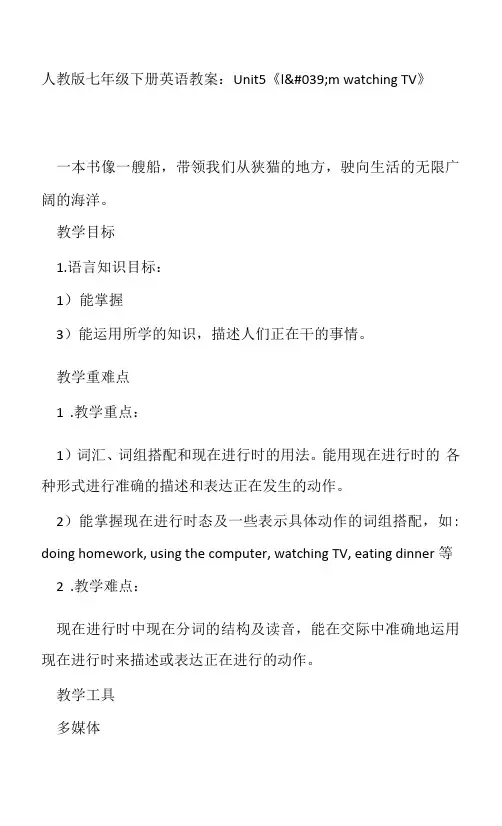
人教版七年级下册英语教案:Unit5《l'm watching TV》一本书像一艘船,带领我们从狭猫的地方,驶向生活的无限广阔的海洋。
教学目标1.语言知识目标:1)能掌握3)能运用所学的知识,描述人们正在干的事情。
教学重难点1.教学重点:1)词汇、词组搭配和现在进行时的用法。
能用现在进行时的各种形式进行准确的描述和表达正在发生的动作。
2)能掌握现在进行时态及一些表示具体动作的词组搭配,如: doing homework, using the computer, watching TV, eating dinner 等2.教学难点:现在进行时中现在分词的结构及读音,能在交际中准确地运用现在进行时来描述或表达正在进行的动作。
教学工具多媒体教学过程EL Warming-up and Lead in1.Greet the Ss and check the homework.2.Watch a video program.固Presentation1.Show some pictures on the big screen. Present the new words and expressions.2.Ss watch and learn the new words and expressions.3.Give Ss some time and try to remember the new words and expressions.4.(Show some pictures on the screen and ask some students to perform the actions.)e.g. T: What are you doing?5.I am doing homework. (Help him/her to answer)6.What is he /she doing?Ss: He /she is doing homework.Teach: watching TV, cleaning, reading a book, eating dinner, talking on the phone...as the same way.5.Work on la. Ss read the activities and look at the pictures. Then match the activities with pictures.6.Check the answers with the Ss.0. Game (guess)1.T: Now lets play a game. Whats she/he doing? You must watch the big screen carefully.(Show some pictures on the big screen quickly) Let Ss guess whats he/she is doing?2.Ss watch and guess the actions.3.Ask and answer about the pictures.Whats he/she doing?Hes/Shes0. Listening1.T: What are Jenny, John, Dave and Mary doing? Now lets listen to the tape, find out the right activities from la.2.Play the recording for the Ss twice.3.Ss listen to the recording and write the numbers from la.团.Pair work1.Ask the Ss to read the conversations in lc with a partner. Then look at the pictures in la. And conversations about other person in the picture.2.Ss make conversations by themselves and practice the conversations.回.Listening1.Work on 2a;T: Jack and Steve are talking on the phone. What are they doing now? Listen to the conversations and match the answers with thequestions.(Play the recording for the first time, students only listen carefully. Then, listen to the recording again, and match the answers with the questions.)Check the answers.2.Work on 2b.Let Ss read the conversation in 2b first. Then play the recording for the Ss twice.The first time Ss only listen and write down the words in the blanks. Then play the recording again for the Ss to check the answers. (If necessary, press the Pause button to help.)0. Pair work1.Now, role-play the conversation with your partners.2.Let some pairs to act out the conversation in front of the class.0. Role-play1. Ask Ss to read the conversation in 2d and answer the questions below.① Are Jenny and Laura talking on the phone?(Yes, they are.)(2) Whats Laura doing now?(Shes washing her clothes.)③ Whats Jenny doing?(Shes watching TV.)(4)When do they meet at Jennys home?(At half past six.)2.Ss read the conversation and answer the questions above.3.Check the answers with the Ss.4.Let Ss work in pairs and role-play the conversation. Homework:1.Review the words and expressions in this period.2.Understand the knowledge about the present progressive tense.3.Make five sentences on what are you doing now.。
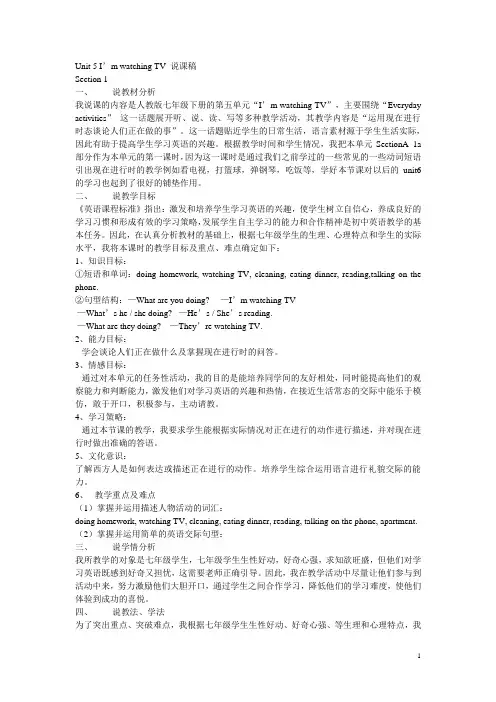
Unit 5 I’m watching TV 说课稿Section 1一、说教材分析我说课的内容是人教版七年级下册的第五单元“I’m watching TV”,主要围绕“Everyday activities”这一话题展开听、说、读、写等多种教学活动,其教学内容是“运用现在进行时态谈论人们正在做的事”。
这一话题贴近学生的日常生活,语言素材源于学生生活实际,因此有助于提高学生学习英语的兴趣。
根据教学时间和学生情况,我把本单元SectionA 1a 部分作为本单元的第一课时,因为这一课时是通过我们之前学过的一些常见的一些动词短语引出现在进行时的教学例如看电视,打篮球,弹钢琴,吃饭等,学好本节课对以后的unit6的学习也起到了很好的铺垫作用。
二、说教学目标《英语课程标准》指出:激发和培养学生学习英语的兴趣,使学生树立自信心,养成良好的学习习惯和形成有效的学习策略,发展学生自主学习的能力和合作精神是初中英语教学的基本任务。
因此,在认真分析教材的基础上,根据七年级学生的生理、心理特点和学生的实际水平,我将本课时的教学目标及重点、难点确定如下:1、知识目标:①短语和单词:doing homework, watching TV, cleaning, eating dinner, reading,talking on the phone.②句型结构:—What are you doing? —I’m watching TV—What’s he / she doing? —He’s / She’s reading.—What are they doing? —They’re watching TV.2、能力目标:学会谈论人们正在做什么及掌握现在进行时的问答。
3、情感目标:通过对本单元的任务性活动,我的目的是能培养同学间的友好相处,同时能提高他们的观察能力和判断能力,激发他们对学习英语的兴趣和热情,在接近生活常态的交际中能乐于模仿,敢于开口,积极参与,主动请教。
书山有路勤为径,学海无涯苦作舟
人教版初一年级英语unit5 说课稿
同学们现在正处于初一阶段,这是一个初中最为关键的时期。
初中频道为大家准备了人教版初一年级英语unit5 说课稿,欢迎阅读与选择!
人教版新目标七年级下Unit5 单元教案
● 1. Vocabulary (Past Simple Tense)
A). Ask Ss to write down all the phases in P25 (picture 1A) under the time axis.
B). Ask Ss to write down the past tense of the verbal phrases.
C). After a small discussion, Ss find out the rules by themselves.
D). Teach them the rules of verbs in past simple tense.
1). regular verbs: + ed. /id/. y i +ed
2). Irregular verbs:
is / was are / were do / did go / went buy / bought
3). 过去时无人称和数的变化。
书中自有黄金屋,书中自有颜如玉。
Unit 5 I’m watching TVLanguage goals:●In this unit students learn to talk about what people are doingNew languages:●What are you doing? I’m doing my homework.●What is he / she doing? He / She is reading.●Is he / she writing a letter? Yes, he / she is. / No, he / she isn’t.●Are you / they playing football? Yes, we /they are. / No, we / they aren’t.●Do you want to go to the movies?●That sounds good.●When do you want to go?●At three o’clock.Difficult points:1. Listen for what people are doing.Listen for the places and everyday activities.Read a letter.Write what someone is doing.2. Present progressive tense.Yes / No questions and short answers.Teaching aids:● A tape recorder●Some picturesTeaching periods:●Period 1:Section A1a, 1b, 1c●Period 2:Section A2a, 2b, 2c●Period 3:Section A3a, 3b, 4●Period 4:Section B 1a, 1b, 1c, 2a,2b, 2c●Period 5:SectionB 3a, 3b, 3c, 4●Period 6:Self CheckPeriod 1Teaching aims:1. Teach vocabulary words.2. Target languages:What are you doing?I’m watching TV.What is he doing?He’s reading.3. Enable the students to talk about what people are doing.4. Help the student learn how to listen to and talk about what people are doing.Teaching procedures:Step 1. Warming up and lead-inPerform some actions and make sentences.Say: Hello, boys and girls. Nice to see you here again.Today we’re going to learn Unit 5. We are going to talk about everyday activities.And now I'll act out some activities and you can guess what I’m doing.Ask the students to repeat the two sentences several times.Open a book and read it.Ask some students to do some simple actions and ask them the questions.Say: I will ask some students to do some simple actions and tell me what you are doing.Step 2.Match work (1a)Ask the students to read the words and the picture, and then match the activities with the pictures a–f.Encourage or help the students to say something about the picture and do the match work.Line next to the words “watching TV.”(as shown below)Go on with the others in the same way. Then check the answers with the students.Step 3. Listening (1b)Ask the students to read the names in activity 1b and write the number from 1a.Play the recording. Let the students just listen.Then point out the blank lines where students will write numbers from 1a.Play the recording for a second time.Ask the students to listen to and read after the recording.Step 4. Pair work (1c)Ask the students to practice: Where is…doing?Show the following:—What’s he / she doing?—He / She is reading / cleaning / doing homework / watching TV /eating dinner / talking on the phone.Homework1. Ask the students to make conversations according to the model below.2. Ask the students to learn the new words and expressions in this unit. (on page 117)Period 2Teaching aims:1. Learn the vocabulary words and useful expressions.2. Target languages:Do you want to go to the movies?That sounds good. The TV show is boring.3. Enable the students to talk about what people are doing.4. Help the student learn how to listen to and talk about what people are doing.Teaching procedures:Step 1. RevisionCheck the homework. Ask some students to work in pairs and make conversations.Then ask some students to do actions and the others describe what he / she is doing.Ask a student to open the door.Ask a second student to write something on the blackboard.Do more activities and let the students answer the questions.Step 2. Listening (2a, 2b)Ask the students to read the two sentences in activity 2a. Then ask them to listen to the conversation and write the answers on the line.Check the answers in the following way.Ask the students to put the four sentences in activity 2b in order.Say: Now read the four sentences. They are in the wrong order. After reading you have to put them in good order. Then you can get a clear conversation. The first part of the conversation is “What are you doing?”Ask the students to listen and check their answers.Step 3. Pair work(2c)Ask three students to take turns doing an activity and others have to close their eyes.Ask questions when the first student is clean the board.Then go on with the second student who is writing on the blackboard.Call attention to the pictures in activity 2c.Say: Now look at the pictures in activity 2c. There are eight pictures here.The pictures show clearly what the students are doing. I give you three minutes to prepare.And then answer my questions.Ask them to work in pairs and take turns asking and answering questions.Ask the students to pay attention to the pictures again.Ask some pairs to present their dialogues in class.Step 4.Grammar focusAsk the students to read the sentences in the grammar box and sum up the sentence structure.Say: Now read aloud the sentences in the grammar box. Then write down the sentence structure in your exercise-books.Ask the students to pay attention to the bold type words in the above form and learn the following.HomeworkAsk the students to do some exercises.Period 3Teaching aims:1. Teach vocabulary words.2. Target languages:Sure, this video is boring.When do you want to go?Let’s go at six o’clock.3. Enable the students to talk about what people are doing.4. Help the students learn how to talk about what people are doing.Teaching procedures:Step 1. Warming upCheck the homework by asking some students to read the sentences.Ask the students to read the following passage and underline thesentences using the present continuous tense.Step 2. Reading and speaking (3a, 3b)Ask the students to finish Activity 3a.Then ask the students to make conversations.Ask some pairs to present their conversations in front.Step 3. Pair work (4)Ask the students to read the pictures in activity 4.Say: Look at the pictures. For each picture there are two questions under it. You have to answer the questions.Give the students a few minutes to prepare.The same goes with the other picture.Ask the students to work to cover the questions under each question.Work in pairs and ask and answer questions.Then ask some pairs to present their dialogues in front of the blackboard, looking at the pictures on the blackboard.HomeworkAsk the students to finish the following exercises after class.Period 4Teaching aims:1. Teach vocabulary words.2. Target languages:Where do people play basketball?At school.Hello! Is Tina there?No, she isn’t. She’s …3. Enable the students to talk about the places where activities take place.4. Help the students learn how to talk about the places where activities take place.Teaching procedures:Step 1. Warming upCheck the homework by asking some students to read the completed passage.Then show the following pictures and ask the students to describe the pictures using the present continuous tense.Step 2. Talk about the places where activities take place (1a)Ask the students to read the pictures.Say, Look at the six pictures. There are some words beneath each picture. I want a student to read the words aloud to the class.Ask the students to answer questions.Ask the students to do the match work.Check the answers in the following way.Say: Which of these words are places? And which of these words are activities? Which of the places will you go to, if you want to borrow books?Step 3. Pair work(1b)Ask the students to read the conversations in pairs.Then ask the students to work in pairs and make similar dialogues about the chart in activity 1b.Ask the students to practice: Where do people…?Step 4. Listening (2a and 2b)Ask the students to listen to the conversations.Say, Now let’s listen to the tape. We are going to hear three conversations. And you have to write the places and the activities you hear.Play the first conversation.Play the first conversation again. Then ask the students to write down where Tina is and what she is doing.Then go on with the other two conversations in the same way.Further activity: Ask the students to do some pair work in the following way if they can understand the listening material well.Then ask them to say the conversation without the help of the recording.Step 5. Pairwork (2b)Point out the example in the speech bubbles in 2c. Ask two students to read it.Then ask the students to work in pairs.Homework1. Fill in the blanks according to the first letter given.2. Ask the students to find some photos or draw some pictures of their own, their family or friends.Period 5Teaching aims:1. Teach vocabulary words.2. Target languages:Thanks for your letter and the photos.I’m playing basketball at school.He’s playing soccer.3. Enable the students to read and write about what people are doing.4. Help the students learn how to read and write about what people are doing.Teaching procedures:Step 1. RevisionAsk the students to pay attention to the pictures on page 28.Say, Look at the pictures in activity 1b on page 28. You have to work in pairs. One of you asks the questions and the other answers.Ask the other students to practice about the other pictures.Step 2. Reading (3a)Ask the students to talk about the pictures in 3a.Ask and answer questions about the second photo.And then ask some pairs to present their conversations to the class.Ask students to read the letter.Answer any questions students may have about the letter.Then ask the students to pay attention to the letter again.Check the answers.And then ask the students to listen to the recording of the letter and read after the tape.Step 3. Reading and writing (3b)Ask the students to pay attention to the picture in activity 3b.Say: Look at the picture, please. What are the people doing? Ask and answer questions in pairs.Ask some students to present their dialogues in class.Ask the students to read the letter.Ask the students to read the letter again and fill in the blanks.Step 4.Writing (3c)Draw a sample picture on the blackboard, in which some people are doing something.Say, Look at the picture. I want you to say something about the picture.Ask students to take out their photos or pictures.Ask some students to present their writing to the class.Step 5.Group work(4)Ask the students to read the conversation and the picture and the picture in 4.Say, Look at the picture in activity 4. There are some students in it. Who can tell me what they are doing?Ask them to share their pictures or photos.Say, Now show your pictures or photos to your classmates near you.Work in pairs.Ask and answer questions like the one in the picture in activity 4.Homework1. Ask the students to do the following exercises.2. Ask the students to write another composition about one of their photos.Period 6Teaching aims:1. Teach vocabulary words.2. Enable the students to write something about some pictures.3. Help the students learn how to write a story by describing what happens in each picture.Teaching procedures:Step 1.Warming upShow some pictures to the students. Show the first picture in which some boys are playing football at school.Show the second picture in which a man is reading a newspaper at home.Give more chances to let them practice.Ask the students to show their photos or pictures.Step 2.Key word check(1)Ask the students to read all the words in this part.Say: Now read and check the words you know in 1 on page 30. Then make a sentence with each of them.Ask the students to check all the words they know.Ask the students to find out the meaning of any wor ds you don’t know.Say: If there are any words you don’t know, you can look them up inyour dictionary and ask me or ask for help from your classmates.Step 3.Vocab-Builder (2)Ask students to write five new words in their Vocabulary-Builder on page 112.Say, Open your books and turn to page 112, please write five new words in your Vocabulary-Builder. You can ask for help from your Chinese-English dictionary.After they are finished, ask two students to write their words down on the blackboard.And ask them to read the words and the whole class repeat.Step 4. Talking about the pictures (3)Ask the students to read the pictures.Say: Now look at the pictures in activity 3. What is happening in each picture? I want you to talk about the pictures. But I think you need some help. Look at the blackboard.Move around the room, checking their progress and offering help if they need.And then ask some pairs to present their statements to the class.Homework1. Ask the students to summarize what they have learned in this unit.2. Ask the students to prepare for the next unit.。
人教版七年级下册英语Unit 5 说课稿一. 教材分析人教版七年级下册英语Unit 5主要讲述了日常生活中的一些活动,如做家务、上学、看电影等。
本单元的核心词汇有housework, homework, watch, read, sports 等,同时本单元还涉及到一般现在时的用法。
通过本单元的学习,学生能够掌握日常生活中的一些基本表达,并能用英语描述自己的日常活动。
二. 学情分析七年级的学生已经具备了一定的英语基础,能够进行简单的英语交流。
但是,部分学生对于一般现在时的用法还不是很清楚,需要老师在教学中进行详细的解释和引导。
此外,学生在口语表达方面还存在一定的困难,需要老师提供更多的机会进行实践和锻炼。
三. 说教学目标1.知识目标:学生能够掌握Unit 5中的核心词汇和短语,理解一般现在时的用法。
2.能力目标:学生能够用英语描述自己的日常活动,进行简单的交流。
3.情感目标:通过学习,学生能够培养对英语的兴趣,增强学习的自信心。
四. 说教学重难点1.重点:学生能够掌握Unit 5中的核心词汇和短语,理解一般现在时的用法。
2.难点:学生能够运用一般现在时描述自己的日常活动,并进行口语交流。
五. 说教学方法与手段1.教学方法:采用任务型教学法,让学生在实际操作中掌握知识,提高能力。
2.教学手段:利用多媒体课件、图片、卡片等辅助教学,增加课堂的趣味性。
六. 说教学过程1.导入:通过展示图片,引导学生谈论自己喜欢的活动,引出本课主题。
2.新课呈现:通过多媒体课件,展示本课的核心词汇和短语,讲解一般现在时的用法。
3.操练:学生分组进行角色扮演,运用一般现在时描述自己的日常活动。
4.巩固:学生完成课堂练习,检测对知识的掌握情况。
5.拓展:引导学生谈论自己的梦想,用英语表达对未来生活的期望。
6.总结:对本课内容进行总结,强调一般现在时的用法。
七. 说板书设计板书设计如下:人教版七年级下册英语Unit 5核心词汇:housework, homework, watch, read, sports等一般现在时:主语 + 动词原形八. 说教学评价1.课堂参与度:观察学生在课堂上的参与情况,是否积极回答问题,参与讨论。
Unit 5 Do you have a soccer ball? 说课稿七年级杨艳丽各位领导,各位老师:大家好,很高兴站在这里和大家一起交流学习。
今天我说课的内容是人教版七年级上册unit 5 do you have a soccer ball, section B的听力部分。
下面我就本节课的教材,教法和学法,教学过程做一个简要的分析。
一、教材分析1.教材简析在人教版初中英语中,本单元有重要的作用。
因为本单元开始,我们会接触到实意动词,学生需要从对“be”动词的学习逐渐过渡到对实意动词的学习中。
本单元主要学习动词have的一般现在时的用法,do 和does引导的一般疑问句的构成以及简单回答。
学习中可能会受到之前“be”动词负迁移的影响,必须多加练习。
今天我要说的是本单元section B的听力部分。
本节课将五个形容词和体育活动,以及相关动词结合起来,是对section A 的扩展。
内容贴合学生生活实际,学生学习兴趣浓厚。
2.学情分析经过前面section A的学习,已基本掌握了have以及do和does的用法。
本节课通过将五个形容词和之前学过的球类结合起来,进一步强化训练do和does 的用法,要学会新的句型“let’s…”来发出邀请,并能用“that sounds …”句型表达自己对某事的看法,相对来说内容较多,难度也比较大,但是通过一系列教学任务的完成,相信学生能在本节课结束的时候掌握几个重要的知识点。
3.教学目标(1)掌握并能熟练运用五个形容词。
interesting, fun, boring, difficult, relaxing(2)能够熟练运用“let’s…”发出邀请,并能用“that sounds …”句型表达自己对某事的看法。
(3)进一步强化训练do和does的用法。
(4)提高学生的听说能力,通过小组活动培养协作团队意识。
(5)让学生通过学习本单元养成热爱运动的好习惯,学着享受生活。
初一Unit5英语说课稿初一Unit5英语说课稿Unit5英语说课稿(一)教材的地位及作用本课是初一新教材第5单元的第一部分,教材内容围围着描述人现在的活动开展,让同学学会谈论人人们正在干什么。
本课的教学内容与同学的实际生活亲密相关,易于引发同学运用简约的英语进行交际和沟通。
在学习活动中,同学能通过交换对不同人物活动的描述,促进同学之间和师生之间的情感沟通,增进情意。
(二)教学目标1、知识目标:Whatareyoudoing?Iamwatching.Whatishedoing?Heisdoinghomework.Isshereading?No,sheisdoingherhomework. 2、技能目标:(1)、能抓住人物的主要特征来描述人物的外貌,并依据描述画出人像。
(2)、能概括人物的外貌特征并依据人物特征推理出某一人物。
3、情感目标:通过描述同学、老师或自己的偶像的外貌,表达自己的看法,使同学在人际交往中学会尊敬和理解别人,学会交换不同的看法,了解他人的爱好,增进情意。
(三)教学重点及难点1、掌控并运用描述人物活动和地点的词汇:watching,doing,eatingcleaning,playing,reading,swimming,shopp ing,pool,school,mall,library2、掌控并运用简约的英语交际句型:Whatareyoudoing?Iamwatching.Whatishedoing?Heisdoinghomework.Isshereading?No,sheisdoingherhomework.(四).教法设计对本课我主要采用了如下几种教法:1.听录音。
听音是英语学习的重要方法,也是课堂教学的重要步骤。
在听中可以感知,可以仿照。
2.重点说明,个别操练。
在每一堂教学中,同学总会遇到一些难以理解的词、句型、短语、句子或某一语法现象。
如本课涌现的一般过去时的用法等都需要老师个别说明甚至创设语言情境进行操练和举例,以扫除自由交际过程中的"拦路虎',为语言的进一步学习奠定基础。
Unit 5 What were you doing when the rainstorm came?It’s my great pleasure to present my lesson plan here. The lesson I’m going to talk about is unit 5 What were you doing when the rainstorm came? I’ll interpret my lesson plan from the following aspects:Firstly, I’d like to analyze the teaching material and learners.This lesson is chosen from the section A of unit 5, Book 8B, PEP Junior English. The topic of this unit is unforgettable events. The main task for ss is to talk about past events. Even though ss have learned the simple past tense, they may still feel hard to talk about past events by using the past progressive tense. Thus, enough practice will be organized to help ss learn the new words, expressions and sentence structures.Based on the analysis above and the new curriculum standard, I set the following teaching aims: 1.Knowledge aim. After the class, ss will understand the function of the past progressive tense and the basic meaning of new vocabulary and the sentence structures, such as alarm, go off, heavily, began, What were you doing when the rainstorm came?2.Ability aim. By the end of the lesson, ss will be better able to talk past events by using the target language.3.Emotional aim. During the class, ss’interest in learning English will be increased by talking about unforgettable events.Next, let’s move on to the key point and difficult point.The key point is to talk past events using the past progressive tense, such as what were you doing at the time of rainstorm?The difficult point is to understand the adverbial clause of time guided by when.To achieve the objectives above, I’ll adopt audio-lingual approach, communicative approach and situational teaching method. And ss will learn through cooperation, communication, discussion and imitation.Now, I’d like to describe the teaching procedure.Step 1 is leading in.At the beginning of the class, I’ll lead in the lesson like this:Hello, boys and girls. I have some beautiful photos to share with you. Now, let’s look at them together. This is a magical astronomical phenomenon, called meter shower. It happened at 8 last night. Did you see it? No, wow, it’s a pity. But it doesn’t matter. Many people were not lucky last night, such as my parents. There was a heavy rainstorm in their city last night.This activity can arouse ss’ interest and lead them to the topic naturally.Step 2 is Presentation.Based on the former activity, I’ll present pictures of my family members. In the pictures, they were doing different things. I’ll talk with ss about what my family members were doing when the rainstorm came. Thus, the past progressive tense will be learned here. 板书What was/were sb doing when/while/at the time of---.After talking about what my parents were doing at the time of rainstorm. I’ll lead ss to match the pictures with the corresponding statements in 1a to see where were the people when the rainstorm came.This activity is used help ss smooth the way for listening.So, next step is listening.ss will listen to a TV report about the rainstorm. While ss listen for the first time, they will circle what people were doing when the rainstorm came. During the second time, ss will read after the recording and check the answers. When they finish, I’ll check the answers by asking questions like “What was the first girl doing when the rainstorm came? What was the man doing at the time of the rainstorm?”Step 4 is speaking.Ss’ll work in pairs to talk about what the people were doing when the rainstorm came in the pictures. Now, ss’ve listened and talked about how to past events. So, I’ll lead ss to the next listening. Here, ss’ll learn to tell a past event.While they listen for the first time, they will find out why yesterday was a terrible day. I’ll encourage ss to guess the meaning of new words and phrases according to the context. As for the 2nd time, ss will number the pictures in time order. When they finish, I’ll explain the new words and phrases. Such as alarm, go off, began, heavily. During the 3rd time, ss will fill in some blanks to complete the story.In this step, ss’ve listened how the boy tell his terrible yesterday. So, next step is a role play.One st will act as a TV reporter. The other st will be the unlucky boy. They will make a conversation about his bad day.Now, let’s talk about the summary.I’ll invite ss to summarize what they have learned from this lesson and then we’ll make a summary together.As for the homework, ss will do a survey in groups of 4. One st will interview the other 3 ss about what they were doing when the meteor shower came last night.At last, I want to introduce my blackboard design.Unit 6 What were you doing when the rainstorm came?What was/were sb doing when/at the time of ----RainstormAlarmGo offBeganHeavily。